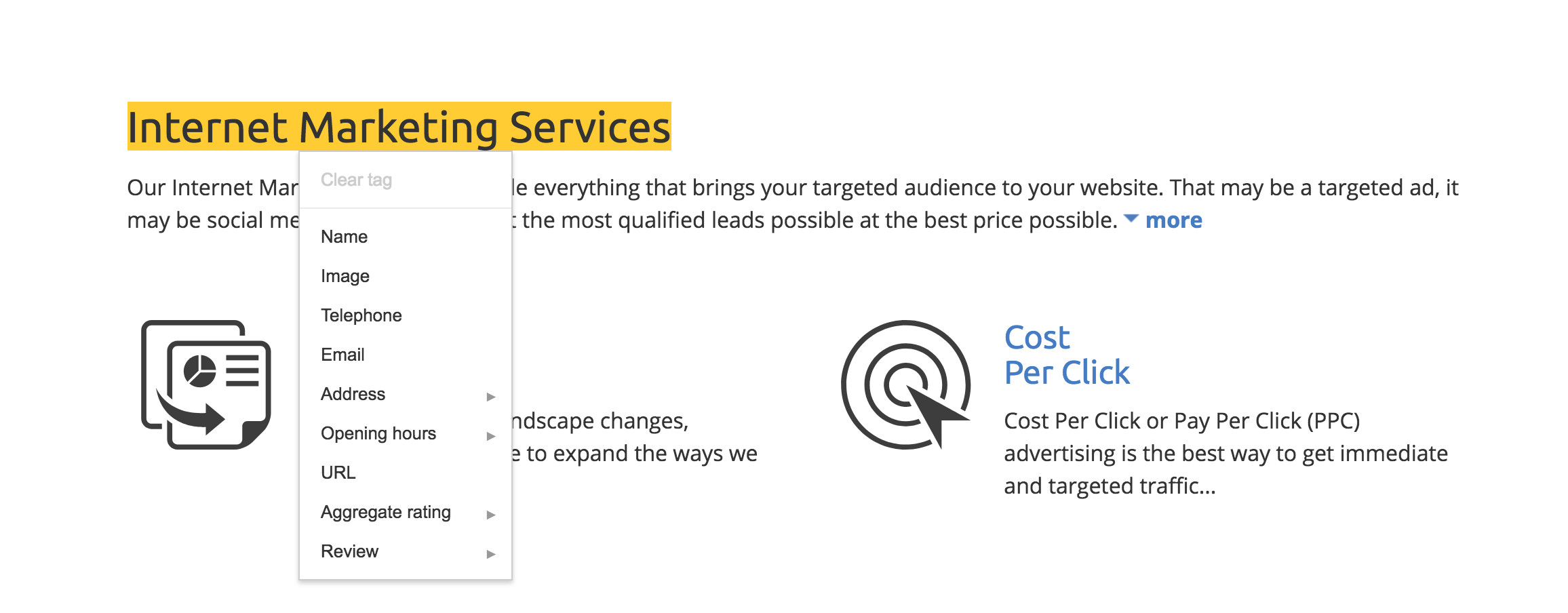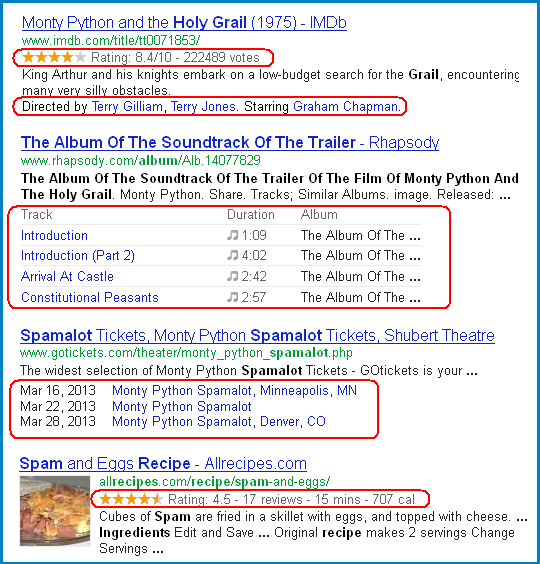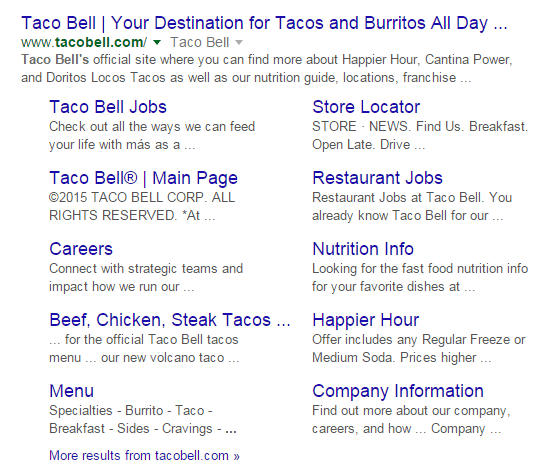What is Schema Markup?
Schema markup tells the search engines what each piece of your page means. It helps identify whether your page contains images, a publisher, the author’s name, publish date, reviews etc.
What are Rich Snippets?
Schema markup works a lot like rich snippets, which allow Google to give searchers more information about your web page on their search results page. Rich snippets can include anything from product reviews to recipes to information panels.
If you aren’t labeling your content, you’re missing out on a large amount of page traffic. The schema.org site was founded by Google, Microsoft, Yahoo and Yandex as an open community process. With a shared vocabulary, webmasters and developers can easily incorporate schema into their website building process. It can be used for articles, local businesses, restaurants, TV episodes and ratings, book reviews, movies, software applications, events, and products. Each page type will have different tags that can be added.
How to Add Schema Markups
Schema markups are code that you incorporate into your website to aid the search engines in returning more informative results for users. You can add tags (microdata) to your site using Google’s Markup Helper. With this tool, all you need to do is identify the type of page content (ie: article, movie, book review, product, etc.), enter the URL, and go through each piece of the page to tag sections with their appropriate label. For an article, this might be date, publisher, image, etc. Once you finish, Google translates all this into code and highlights the schema markups that you’ll need to add into your CMS’s HTML. Once you’ve made the proper changes, check your work with Google’s Structured Data Testing Tool. Structured data is a system of pairing a name with a value that helps search engines categorize and index your content. If you want to go into more detail with your markups, you can categorize events, include ISBN numbers for products, or add the time of publication as well as the date.
Will it Help My Ranking?
Though there is no conclusive evidence that schema markups improve ranking, search results with more extensive rich snippets (like Schema) have better click-through-rates. In addition, one study found that websites with markups rank an average of four positions higher in the SERPs than those without markups. Of course, there are other variables to consider as well. Most companies using schema markups are knowledgeable about SEO tactics and may be implementing other strategies to boost their ranking besides markups. However, the numbers speak for themselves. Retail firms can achieve up to a 30 percent increase in organic traffic just by using structured markups. If you have a review system set up for your products, it might be a good idea to display these ratings in your markup. That way, these high ratings show up on the SERP.
Types of Rich Snippets
If you have a storefront, your Google listing might have a ‘popular times’ chart as well. This snippet, introduced in 2015, let’s customers find the best time for them to visit your store to avoid large crowds. Another snippet introduced in 2015 is the ‘book an appointment’ feature on the knowledge panel. It was created by Demandforce and makes it easy for mobile users to quickly utilize your service. The organic with virtual path rich snippet is a breadcrumb-style path that replaces the URL and is most common on mobile devices. This is a good resource for searchers to see if their query falls in the category that your page is under. An organic result with long snippet has a meta-description (text featured under the listing title) that exceeds 155 characters. Google is constantly changing their limits for meta descriptions though, and you can’t always be sure what’s a permanent algorithm change and what’s A/B testing. For those in the coveted #1 organic position, you might just get your full sitelinks (1-6) featured. Keep in mind that each row of sitelinks displaces one organic result, so you’re also knocking out the competition. Organic results with mega-sitelinks (pictured below) are similar, except they only show up when someone searches your exact brand name. Since Google knows that you have clear brand intent, it will bring up 10 sitelinks, booting out five organic positions.
Another beneficial feature to have in rich snippets is internal search, an amenity found most often with ecommerce sites. With this rich snippet (normally shown when search has clear brand intent), Google gives you a search bar under the page description. That way, you can search the site for a specific query without leaving the SERP. For those who boast high product ratings, a star review widget might be the perfect rich snippet to draw in customers. They are shown between the destination URL and snippet.
With a ‘News Results’ rich snippet, you can get your time-sensitive and newsworthy topics featured under the ‘news’ section of a Google Search. These results often show up in regular searches as well, tagged under a news tag. In 2015, there was a Twitter Results update rolled out that allowed relevant tweets to appear directly in the SERPs. The knowledge panels are geared toward larger brands, and they offer more detailed information about the company. In addition, Google can recognize smaller brands and local businesses and give them similar rich snippet listings. Much like Google’s Answer Box results, the featured snippet allows you to bypass the people who work their butt off for that high SEO ranking. Basically, you get to skip the line! The featured snippet is pulled up when Google wants to answer a question that isn’t in the core Knowledge Graph. Google checks the index and creates a special class of organic results with info extracted from the target page.
Local Packs
While many are familiar with the concept of location-based SERPs, local packs changed their formatting in 2015 to more closely align with Google Maps. Instead of the previous 2-7 result local pack that blended in with organic results, they created a 2-3 result entity which would make it more difficult for local businesses to gain the coveted first-page position without some SEO tactics. The local A/B/C packs come with alphabetical assignments and map pins to make it easy for searches to see what’s closest to them. This occurs mostly when the locations in the pack are related, such as a chain with multiple locations. A local knowledge panel shows info about local businesses, such as phone number, address, hours, reviews, etc.
The Importance of Marking Content
Google tells you straight up that it’s important to mark your content, and rich snippets have been known to increase conversion rates by funneling more high-intent traffic to your website. According to a Moz article, some companies have experienced a 20-30% rise in click-through rates by utilizing rich snippets. With rich snippets, users can acquire more information about the page before clicking through to your website. This lowers your bounce rate and makes your listing stand out among the competitors. By including rich snippets on your product page, users will be able to see your product’s availability, pricing and reviews before they even visit your site. The more information you can give users, the better! Think of the rich snippet as your marketing pitch—what information can you give users to convince them to complete a conversion? In one client study, a featured snippet yielded 41,444 clicks in 90 days. This made up 73% of the client’s traffic from Google and had a click-through-rate of 13.2%. Keep in mind though that the Google algorithm can be wishy-washy when it comes to featured snippets. Your featured snippet might be there one week and randomly disappear the next week. Though you don’t need a number one Google ranking to earn a featured snippet, you do need to be on the first page of results.
A Multi-Faceted Approach
When it comes down to it, on-site work isn’t going to do the trick anymore. You’ll need a combination of AdWords, featured snippets, a spot in the local packs and high organic ranking. This can be accomplished through a combination of tools. For one, some WordPress themes have schema markups that are built in. If you’d rather use schema markup plugins, you can use Schema App Structured Data to edit your WordPress site’s schema markup directly (no coding knowledge required). Another option is the All in One Schema.org Rich Snippets plugin. We use SEMRush in our own SEO work, since it gives you competitive data. You can use it to check your competitors’ keywords and see which of them trigger certain SERP features like local packs or Google News.
Contact Us
If you’re interested in incorporating scheme markups and rich snippets into your marketing strategy, contact us. Whether you’re looking for some SEO assistance or want to learn more about how content marketing can boost your ROI, we would love to get started on an internet marketing campaign for your business. Schema markups and rich snippets are a great option if you have a lower budget but know that you’re already ranking on the first page of Google results for some high search-volume keywords.







